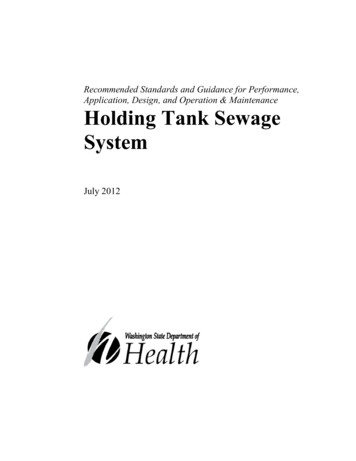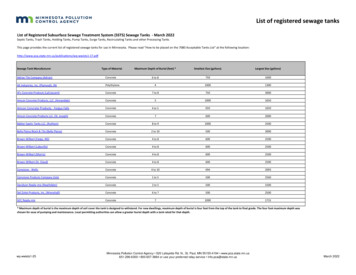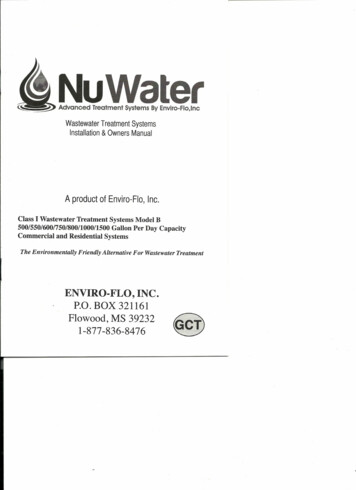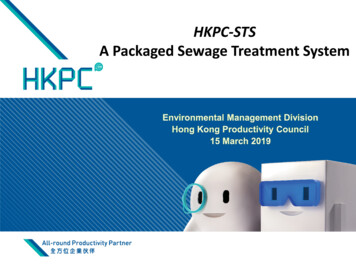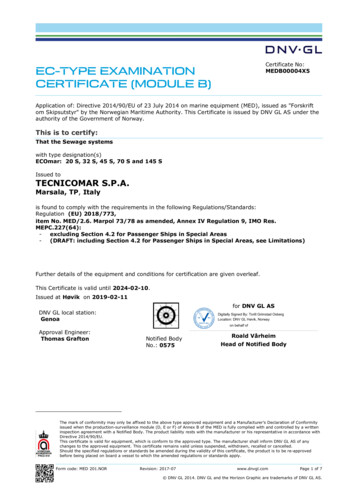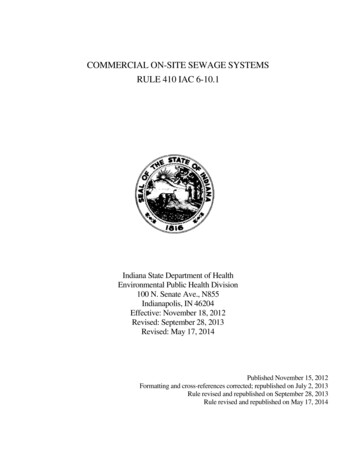
Transcription
COMMERCIAL ON-SITE SEWAGE SYSTEMSRULE 410 IAC 6-10.1Indiana State Department of HealthEnvironmental Public Health Division100 N. Senate Ave., N855Indianapolis, IN 46204Effective: November 18, 2012Revised: September 28, 2013Revised: May 17, 2014Published November 15, 2012Formatting and cross-references corrected; republished on July 2, 2013Rule revised and republished on September 28, 2013Rule revised and republished on May 17, 2014
410 IAC 6-10.1, Commercial On-site Sewage SystemsTable of ContentsSec. 1-47 Definitions .1Sec. 48 Administrative authority .6Sec. 49 General sewage disposal requirements .6Sec. 50 Construction permit requirements.7Sec. 51 Application for construction permit .8Sec. 52 Standards for issuance.9Sec. 53 Construction permit conditions .9Sec. 54 Operating permits.10Sec. 55 Denial of an application for a construction or operating permit .11Sec. 56 Revocation or modification of a construction or operating permit .11Sec. 57 Petitions for appeal .11Sec. 58 Violations .12Sec. 59 Construction and operating permit; transferability .12Sec. 60 Sewage flows .13Sec. 61 Minimum separation distances .15Sec. 62 Dispersal area .17Sec. 63 Drainage .18Sec. 64 On-site evaluation .20Sec. 65 Construction of sewers.21Sec. 66 Grease traps.22Sec. 67 Sewage lift stations and force mains .22Sec. 68 Septic tanks: general requirements .23Sec. 69 Septic tanks: construction details .24Sec. 70 Dosing tanks .26Sec. 71 Septic tanks and dosing tanks: installation and maintenance.26Sec. 72 Outlet filters .27Sec. 73 Effluent pumps .28Sec. 74 Distribution box specifications .29Sec. 75 Pipe specifications .30Sec. 76 Aggregate specifications .31Sec. 77 Barrier materials.31Sec. 78 Subsurface trench on-site sewage system site suitability.31Sec. 79 Subsurface trench on-site sewage system type selection criteria .33Sec. 80 Elevated sand mound on-site sewage system site suitability .35Sec. 81 Table for on-site sewage system selection .37Sec. 82 Subsurface trench on-site sewage systems: general design and construction requirements .38Sec. 83 Subsurface trench gravity on-site sewage systems: design and construction requirements.40Sec. 84 Subsurface trench flood dosed on-site sewage systems: design and construction requirements .41Sec. 85 Subsurface trench alternating field on-site sewage systems: design and construction requirements .44Sec. 86 Subsurface trench pressure distribution on-site sewage systems: design and construction requirements . 44Sec. 87 Elevated sand mound on-site sewage systems: design of the aggregate bed .47Sec. 88 Elevated sand mound on-site sewage systems: design of basal area .50Sec. 89 Elevated sand mound on-site sewage systems: dimensions of the elevated sand mound .51i
Sec. 90 Elevated sand mound on-site sewage systems: pressure distribution network .51Sec. 91 Elevated sand mound on-site sewage systems: protection of the site .54Sec. 92 Elevated sand mound on-site sewage systems: requirements for system construction.54Sec. 93 Elevated sand mound on-site sewage systems: installation of the effluent force main .55Sec. 94 Elevated sand mound on-site sewage systems: preparation of the site .55Sec. 95 Elevated sand mound on-site sewage systems: placement of the sand on the basal area .56Sec. 96 Elevated sand mound on-site sewage systems: construction of the aggregate bed .56Sec. 97 Elevated sand mound on-site sewage systems: placement of the soil material and final grade.56Sec. 98 Abandonment of an on-site sewage system .57Sec. 99 Matters incorporated by reference .58410 IAC 6-10.1, Commercial On-site Sewage SystemsList of Tables and FiguresTable I – Estimated Sewage Flows.13Table II – Minimum Separation Distances .15Table III – Minimum Dispersal Area for Soil Absorption Systems .17Table IV – Minimum Slope for Sewers .21Table V – Soil Loading Rates for Subsurface Trench On-site Sewage Systems.33Table VI – Soil Loading Rates for Elevated Sand Mound On-site Sewage Systems .36Table VII – Table for On-site Sewage System Selection based on requirements of 410 IAC 6-8.3 .37Table VIII – Required Effluent Pump Discharge Rates for Subsurface Trench Flood DosedOn-site Sewage Systems .41Table IX – Frost Penetrations in Indiana .42Table X – Friction Losses in Plastic Pipe .43Table XI – Plastic Pipe Fittings: Friction Loss – Equivalent Length of Straight Pipe .44Table XII – Manifold Diameters for Various Manifold Lengths, Number of Laterals,and Lateral Discharge Rates .45Table XIII – Pipe Volume for Various Diameter Pipes.46Table XIV – Soil Loading Rates Versus Pressure Distribution Lateral Hole Spacing for Subsurface TrenchPressure Distribution Systems .46Table XV – Perforation Discharge Rates in GPM at Varying Inline Heads for ¼ Inch Diameter Hole Size .46Table XVI – INDOT Specification 23 Sand.51Table XVII – Pressure Distribution Lateral Diameter for Elevated Sand Mounds .52Figure 1 – Plan View of Sand Mound .49Figure 2 – Plan View of Pressure Distribution Laterals in an Aggregate Bed of an Elevated Sand Mound .53ii
410 IAC 6-10.1-1 DefinitionsSec. 1. The definitions in this rule apply throughout this rule.410 IAC 6-10.1-2 "AASHTO" definedSec. 2. "AASHTO" means the American Association of State Highway and Transportation Officials.410 IAC 6-10.1-3 "ABS" definedSec. 3. "ABS" means acrylonitrile-butadiene-styrene.410 IAC 6-10.1-4 "ANSI" definedSec. 4. "ANSI" means the American National Standards Institute.410 IAC 6-10.1-5 "ASTM" definedSec. 5. "ASTM" means the American Society for Testing and Materials.410 IAC 6-10.1-6 "Cluster system" definedSec. 6. "Cluster system" means an on-site sewage system designed to serve two (2) or more sewagegenerating dwellings or facilities with multiple owners. Typically, the term includes a comprehensive, sequentialland-use planning component and private ownership.410 IAC 6-10.1-7 "Commissioner" definedSec. 7. "Commissioner" means the commissioner of the department or his or her legally authorizedrepresentative.410 IAC 6-10.1-8 "Commercial on-site sewage system" or "on-site sewage system" definedSec. 8. "Commercial on-site sewage system" or "on-site sewage system" means all equipment and devicesnecessary for proper conduction, collection, storage, treatment, and on-site disposal of sewage from other than onefamily or two-family dwellings, except where such dwellings are connected to a cluster system. However, an on-sitesewage system serving two (2) single-family dwellings on the same property, with a combined DDF of less than orequal to seven hundred fifty (750) gallons per day, is a residential on-site sewage system, not a commercial on-sitesewage system. Included within, but not limited to, the scope of this definition are building sewers, grease traps,septic tanks, dosing tanks, absorption fields, perimeter drains, vault privies, and temporary sewage holding tanksserving such facilities as the following:(1) Apartment buildings.(2) Campgrounds.(3) Churches.(4) Commercial establishments.(5) Condominiums.(6) Medical facilities.(7) Mobile home parks.(8) Motels.(9) Office buildings.(10) Restaurants.(11) Schools.1
Section 9410 IAC 6-10.1-9 "Commercial on-site sewage system failure" definedSec. 9. "Commercial on-site sewage system failure" means a commercial on-site sewage system that exhibitsone (1) or more of the following:(1) The on-site sewage system refuses to accept sewage at the rate of designapplication thereby interfering with the normal use of commercial plumbing fixtures.(2) Effluent discharge exceeds the absorptive capacity of the soil, resulting in ponding, seepage, or otherdischarge of the effluent to the ground surface or to surface waters.(3) Effluent is discharged from the onsite sewage system causing contamination of a potable water supply, ground water, or surface waters.A failed commercial on-site sewage system is a health hazard.410 IAC 6-10.1-10 "Construction permit" definedSec. 10. "Construction permit" means written approval by the department for the installation, repair, orreplacement of a commercial on-site sewage system.410 IAC 6-10.1-11 "Densic material" definedSec. 11. "Densic material" means relatively unaltered materials (do not meet requirements for any othernamed diagnostic horizons nor any other diagnostic soil characteristic) that have a noncemented rupture resistanceclass. The bulk density or the organization is such that roots cannot enter, except in cracks. These are mostly earthymaterials, such as till, volcanic mudflows, and some mechanically compacted materials. Some noncemented rockcan be densic materials if they are dense or resistant enough to keep roots from entering, except in cracks. Densicmaterials are noncemented and thus differ from paralithic materials and the material below a lithic contact, both ofwhich are cemented. Densic materials have, at their upper boundary, a densic contact if they have no cracks or if thespacing of cracks that roots can enter is ten (10) centimeters (cm) or more. These materials can be used todifferentiate soil series if the materials are within the series control section.410 IAC 6-10.1-12 "Department" definedSec. 12. "Department" means the Indiana state department of health.410 IAC 6-10.1-13 "Design daily flow" or "DDF" definedSec. 13. "Design daily flow" or "DDF" means the calculated peak daily sewage flow from a commercialfacility used to design a commercial on-site sewage system.410 IAC 6-10.1-14 "Distribution box" definedSec. 14. "Distribution box" means a structure designed to distribute effluent by gravity from a septic tankequally into the trenches of the soil absorption system connected thereto.410 IAC 6-10.1-15 "Drainageway" definedSec. 15. "Drainageway" means the channel portion of the landscape in which surface water or rainwaterrunoff gathers intermittently to flow to a lower elevation.410 IAC 6-10.1-16 "Dwelling" or "residence" definedSec. 16. "Dwelling" or "residence" means any house or place used or intended to be used as a place ofseasonal or permanent human habitation or for sleeping for one (1) or two (2) families, and any associatedoutbuildings that are for the private use of the owner.2
Section 17410 IAC 6-10.1-17 "Fill" definedSec. 17. "Fill" means soil transported and deposited by man, as well as soil recently transported anddeposited by natural erosion forces. Fill is evidenced by one (1) or more of the following:(1) No soil horizons or indistinct soil horizons.(2) Depositional stratification.(3) Presence of a soil horizon that has been covered.(4) Materials in a horizon such as cinders or construction debris.(5) Position in the landscape.410 IAC 6-10.1-18 "Grease trap" definedSec. 18. "Grease trap" means a tank designed to intercept, congeal, and retain or remove fats, oils, andgrease (FOGs) from sewage.410 IAC 6-10.1-19 "Health officer" definedSec. 19. "Health officer" means the health officer of a local board of health.410 IAC 6-10.1-20 "High strength waste" definedSec. 20. "High strength waste" means either of the following as defined by National Sanitation FoundationInternational (NSF) Standard 40 testing protocol:(1) Influent to a septic tank or other pretreatment component having any or all of the following:(A) A five (5) day biochemical demand (BOD5) greater than three hundred (300) mg/L.(B) Total suspended solids (TSS) greater than two hundred (200) mg/L.(C) Fats, oils, and grease (FOGs) greater than fifty (50) mg/L.(2) Effluent from a septic tank or other pretreatment component discharged to a soil absorption field havingany or all of the following:(A) A BOD5 greater than one hundred seventy (170) mg/L.(B) TSS greater than sixty (60) mg/L.(C) FOGs greater than twenty-five (25) mg/L.410 IAC 6-10.1-21 "INDOT" definedSec. 21. "INDOT" means the Indiana department of transportation.410 IAC 6-10.1-22 "Interceptor drain" definedSec. 22. "Interceptor drain" means a subsurface drainage system constructed only on the upslope side orsides of a soil absorption system for the purpose of diverting subsurface water around the soil absorption system site.410 IAC 6-10.1-23 "Local health department" definedSec. 23. "Local health department" means a local health department created pursuant to IC 16-20, or its dulyauthorized representative.410 IAC 6-10.1-24 "NEMA" definedSec. 24. "NEMA" means the National Electrical Manufacturers Association.410 IAC 6-10.1-25 "NRCS" definedSec. 25. "NRCS" means the United States Department of Agriculture, Natural Resources ConservationService.410 IAC 6-10.1-26 "NSF" definedSec. 26. "NSF" means the National Sanitation Foundation International.3
Section 27410 IAC 6-10.1-27 "Operating permit" definedSec. 27. "Operating permit" means written approval by the department for the continued use andmaintenance of a commercial on-site sewage system.410 IAC 6-10.1-28 "Owner" definedSec. 28. "Owner" means the owner of a commercial facility or dwelling or his or her agent.410 IAC 6-10.1-29 "Perimeter drain" definedSec. 29. "Perimeter drain" means a subsurface drainage system that completely surrounds a soil absorptionsystem for the purpose of lowering a seasonal high water table or preventing movement of subsurface water into asoil absorption system site.410 IAC 6-10.1-30 "Person" definedSec. 30. "Person" means any:(1) individual;(2) partnership;(3) copartnership;(4) firm;(5) company;(6) corporation;(7) association;(8) trust;(9) estate; or(10) other legal entity, its or their successors, assigns, or agents.410 IAC 6-10.1-31 "PVC" definedSec. 31. "PVC" means polyvinyl chloride.410 IAC 6-10.1-32 "Regulatory flood elevation" or "RFE" definedSec. 32. "Regulatory flood elevation" or "RFE" means the elevation of surface water resulting from a floodfor which there is a one percent (1%) probability of equaling or exceeding that level in any given year as calculatedby a method and procedure that is approved by the Indiana natural resources commission. The regulatory floodelevation is also referred to as the base flood elevation.410 IAC 6-10.1-33 "Sanitary sewerage system" definedSec. 33. "Sanitary sewerage system" means a sewer or a system of sewers that conveys sewage away fromthe property on which it originates to a wastewater treatment facility owned and operated by:(1) an incorporated city or town;(2) a conservancy district;(3) a regional sewer district; or(4) a private utility.410 IAC 6-10.1-34 "SDR" definedSec. 34. "SDR" means standard dimension ratio.410 IAC 6-10.1-35 "Seasonal high water table" definedSec. 35. "Seasonal high water table" means the upper limit of soil saturated with water for periods longenough for anaerobic conditions to affect soil color.4
Section 36410 IAC 6-10.1-36 "Segment drain" definedSec. 36. "Segment drain" means a subsurface drainage system constructed between two (2) soil absorptionfields in the same on-site sewage system for the purpose of intercepting and diverting subsurface water away fromthe downslope soil absorption field.410 IAC 6-10.1-37 "Septic tank" definedSec. 37. "Septic tank" means a watertight structure into which sewage is discharged for settling and solidsdigestion.410 IAC 6-10.1-38 "Sewage" definedSec. 38. "Sewage" means all water-carried waste derived from ordinary living processes.410 IAC 6-10.1-39 "Soil absorption" definedSec. 39. "Soil absorption" means a process that utilizes the soil to treat and disperse effluent from a septictank.410 IAC 6-10.1-40 "Soil absorption system" or "soil absorption field" definedSec. 40. "Soil absorption system" or "soil absorption field" means pipes or chambers laid in a system ofsubsurface trenches or pipes laid in elevated beds into which the effluent from the septic tank is discharged into thesoil for treatment and dispersal.410 IAC 6-10.1-41 "Soil horizon" definedSec. 41. "Soil horizon" means a layer of soil or soil material approximately parallel to the land surface anddiffering from adjacent genetically related layers in physical, chemical, and biological properties or characteristicssuch as:(1) color;(2) structure;(3) texture;(4) consistence;(5) kinds and numbers of organisms present; and(6) degree of acidity or alkalinity.410 IAC 6-10.1-42 "Soil loading rate" definedSec. 42. "Soil loading rate" means the allowable rate of application of septic tank effluent to the soil. It isexpressed in gallons per day per square foot.410 IAC 6-10.1-43 "Soil profile analysis" definedSec. 43. "Soil profile analysis" means the observation and evaluation of the physical characteristics of thesoil horizons or layers to:(1) a depth of at least five (5) feet; or(2) if shallower, a layer that cannot be readily penetrated.410 IAC 6-10.1-44 "Soil scientist" definedSec. 44. "Soil scientist" means an individual registered as a professional soil scientist with the IndianaRegistry of Soil Scientists (IRSS) as provided for under IC 25-31.5.410 IAC 6-10.1-45 "Start of construction" definedSec. 45. "Start of construction" means, but is not limited to, any site activity undertaken for the erection of astructure to be served by a commercial on-site sewage system.5
Section 46410 IAC 6-10.1-46 "Subsurface drainage system" definedSec. 46. "Subsurface drainage system" means any pipe with or without a layer of gravel, stone, or coarsesand, placed below the surface of the ground and designed or constructed in such a manner as to:(1) effectively lower a seasonal high water table; or(2) prevent movement of subsurface water into a soil absorption system site.Interceptor drains, perimeter drains, and segment drains are types of subsurface drainage systems.410 IAC 6-10.1-47 "Technology new to Indiana" or "TNI" definedSec. 47. "Technology new to Indiana" or "TNI" means on-site sewage treatment or disposal methods,processes, or equipment not described in this rule that have been approved by the department in accordance withsection 49(h) of this rule.410 IAC 6-10.1-48 Administrative authoritySec. 48. (a) The department, its agent, or the health officer or his or her agent shall be permitted to enterupon all properties at the proper time for the following purposes necessary to achieve compliance with this rule:(1) Inspection.(2) Observation.(3) Measurement.(4) Sampling.(5) Testing.(b) The department may delegate, in writing, to local health departments the plan review, approval, permitissuance, and inspection for individual commercial facilities with on-site sewage systems with a design daily flow ofless than or equal to seven hundred fifty (750) gallons when the local health department complies with therequirements of the department for plan review, approval, and permit issuance. The department may revoke, inwriting, such delegation when a local health department fails to comply with the requirements of the department forplan review, approval, and permit issuance. Local health departments may review plans and issue permits based ondelegation when the department:(1) has designated which on-site sewage system technologies are delegated to the local health department forplan review, approval, and permit issuance; and(2) has provided design criteria to the local health department for each individual commercial on-site sewagesystem project.410 IAC 6-10.1-49 General sewage disposal requirementsSec. 49. (a) No person shall throw, run, drain, seep, or otherwise dispose into any of the surface waters orground waters of this state, or cause, permit, or suffer to be thrown, run, drained, allowed to seep, or otherwisedisposed into such waters, any organic or inorganic matter from a commercial facility or commercial on-site sewagesystem that would cause or contribute to a health hazard or water pollution.(b) The:(1) design;(2) construction;(3) installation;(4) location;(5) maintenance; and(6) operation;of commercial on-site sewage systems shall comply with the provisions of this rule.(c) All commercial on-site sewage systems utilizing sanitary privies shall conform to department bulletin SE11, "The Sanitary Vault Privy", 1986 Edition.6
Section 49(d)(d) Any commercial facility that is not connected, or cannot be connected, to a sanitary sewerage systemshall be provided with a commercial on-site sewage system that includes a septic tank and a soil absorption systemthat has not failed.(e) A temporary sewage holding tank is an alternative method of sewage disposal subject to the writtenapproval of the department. A temporary sewage holding tank shall not be used as a primary means of commercialsewage disposal except:(1) where necessary to prevent continued discharge of sewage from a failed existing commercial on-sitesewage system;(2) when soil conditions exist that preclude the prompt construction of a soil absorption system on a site thathas already received a construction permit; or(3) where the holding tank is operated by a conservancy district, sewer district, private utility, ormunicipality as a part of its sewage disposal plan or for not more than two (2) years while connection tosanitary sewer is being secured. This two (2) year time frame may be extended upon documentation ofsatisfactory operation of the holding tank.(f) No portion of the commercial on-site sewage system or its associated drainage system shall beconstructed upon property other than that from which the sewage originates unless easements, which grantpermission for such construction and access for system maintenance, have been obtained for that propertyand have been legally approved and recorded by the proper authority or commission.(g) Commercial on-site sewage systems shall not be used for the disposal of water from:(1) roof drains;(2) foundation drains;(3) swimming pool main drains;(4) hot tub drains; or(5) area drains.Neither shall they be used for the disposal of chemical wastes in quantities that would pollute ground water or inhibitsolids settling or digestion in the septic tank.(h) In order to encourage development of new or more efficient treatment or disposal processes, thedepartment may issue construction permits for experimental and TNI commercial on-site sewage systems.Construction permits may be issued for installations, treatment, or disposal equipment, processes, or techniques forwhich extensive experience or records of use have not been developed in Indiana. However, the applicant mustsubmit evidence of sufficient clarity and conclusiveness to convince the department that the proposal has areasonable and substantial probability of satisfactory operation without causing a health hazard, nuisance, surfacewater pollution, or ground water pollution. The department may also require the applicant to satisfactorily documenthow and by whom the experimental facilities and any other portions of the commercial on-site sewage system,which could be damaged due to a failure of the experimental installation, are to be replaced if it becomes necessary.410 IAC 6-10.1-50 Construction permit requirementsSec. 50. (a) Except as allowed by subsection (c), or section 48(b) of this rule, for any commercial facilitythat will not be connected to a sanitary sewerage system, the owner or agent of the owner shall obtain a writtenconstruction permit, signed by the commissioner or his or her duly authorized representative, for construction of acommercial on-site sewage system prior to the:(1) start of construction of a commercial facility;(2) start of construction of a regulated facility;(3) reconstruction of any commercial or regulated facility;(4) addition to, alteration of, replacement, or repair
Sec. 8. "Commercial on-site sewage system" or "on-site sewage system" means all equipment and devices necessary for proper conduction, collection, storage, treatment, and onsite disposal of - sewage from other than one-
